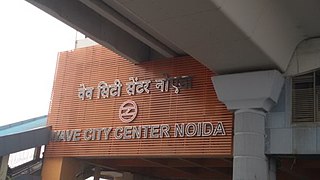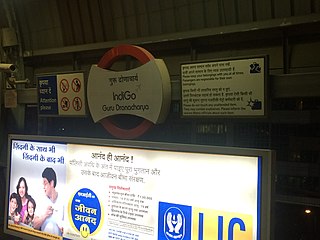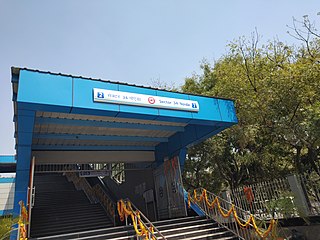
Delhi has significant reliance on its transport infrastructure. The city has developed a highly efficient public transport system with the introduction of the Delhi Metro, which is undergoing a rapid modernization and expansion since 2006. There are 16.6 million registered vehicles in the city as of 30 June 2014, which is the highest in the world among all cities, most of which do not follow any pollution emission norm, while the Delhi metropolitan region has 11.2 million vehicles. Delhi and NCR lose nearly 42 crore man-hours every month while commuting between home and office through public transport, due to the traffic congestion. Therefore, serious efforts, including a number of transport infrastructure projects, are under way to encourage usage of public transport in the city.

Yamuna Expressway is a 6-lane wide and 165.5 km (102.8 mi) long access-controlled expressway in the Indian state of Uttar Pradesh. It is presently India's sixth longest expressway and connects Greater Noida with Agra. It was built to de-congest the older Delhi–Agra national highway (NH-2) or Mathura Road.

Noida City Centre is a station on the Blue Line of the Delhi Metro. It was the terminal station of the Blue Line - Main Line till 8 March 2019. It was earlier known as Noida City Centre, and was renamed in October 2015. Trains from here go to Dwarka Sector 21 metro station and Noida Electronic City metro station.

The Botanical Garden is an interchange metro station in Noida between the Blue Line and Magenta Line of the Delhi Metro. It serves as one of the terminal stations of the Magenta line. On May 3, 2024, the metro station was honoured with the title of the "Best Metro Station". This accolade was announced by DMRC on its 30th foundation day held at Bharat Mandapam in New Delhi.

The Noida Sector 15 is a metro station on the Blue Line of the Delhi Metro.

The New Ashok Nagar Metro Station is a metro station on the Blue Line of the Delhi Metro.

The Guru Dronacharya metro station is located on the Yellow Line of the Delhi Metro. It is the First Metro Station in Gurugram, in the state of Haryana.

The IFFCO Chowk metro station is located on the Yellow Line of the Delhi Metro.

The Delhi Metro is a rapid transit system that serves Delhi and the adjoining satellite cities of Ghaziabad, Faridabad, Gurugram, Noida, Bahadurgarh, and Ballabhgarh in the National Capital Region of India. The system consists of 10 colour-coded lines serving 256 stations, with a total length of 350.42 kilometres (217.74 mi). It is India's largest and busiest metro rail system and the second-oldest, after the Kolkata Metro. The metro has a mix of underground, at-grade, and elevated stations using broad-gauge and standard-gauge tracks. The metro makes over 4,300 trips daily.

The Noida Metro is a rapid transit system serving the twin cities of Noida and Greater Noida in Uttar Pradesh, India. The metro network consists of one line, with a total length of 29.7 kilometres (18.5 mi) serving 21 stations. The system has all elevated stations using standard-gauge tracks.

The Noida Sector 61 is a metro station on the Blue Line extension of the Delhi Metro railway, in the city of Noida in India.

The Noida Sector 34 is a metro station on the Blue Line extension of the Delhi Metro railway, in the city of Noida in India.

The Okhla Vihar metro station is located on the Magenta Line of the Delhi Metro. It is located in Abul Fazal Enclave just behind Jamia Nagar Police station. This Metro station has three gates. One named as Abul Fazal Enclave Part-I another Hari Kothi Road and the last one as Jamia Nagar Police Station.

The Okhla Bird Sanctuary metro station is located on the Magenta Line of the Delhi Metro. It is located in the Okhla Bird Sanctuary, Sector 94, Noida, Uttar Pradesh, India. which is one of the 466 IBAs of India.
The Jaypee Greens Pari Chowk is an elevated metro station on the North-South corridor of the Aqua Line of Noida Metro in the area of Knowledge Park I, Greater Noida, Uttar Pradesh, India. It was opened on 25 January 2019.

Noida Sector 52 is a metro station on the Blue Line extension of the Delhi Metro in the city of Noida, India.

The Noida Sector 59 is a metro station on the Blue Line extension of the Delhi Metro railway, in the city of Noida in India.

The Noida Sector 62 is a metro station on the Blue Line extension of the Delhi Metro railway, in the city of Noida in India.
The Ghaziabad–Jewar Regional Rapid Transit System is a proposed 72.44 km (45.01 mi) semi high-speed rail and regional transit corridor that will connect the National Capital Region cities of Ghaziabad and Noida with Noida International Airport at Jewar. It is the fourth of the four rapid rail corridors planned under the first phase of the RapidX project managed by the National Capital Region Transport Corporation (NCRTC). It will be built to allow a maximum speed of 180 km/h (110 mph), and the distance between Ghaziabad, Noida and the airport will be covered in less than 40–50 minutes. The project is estimated to cost approximately ₹20,640 crore. It will originate from Ghaziabad, run through Noida, Greater Noida, YEIDA City and end at the Noida International Airport at Jewar. It will have 12 stations and two depots on both the northern and southern ends of the corridor.






















